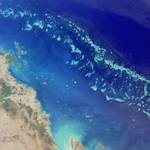Galapagos Marine Reserve, among the world's most biologically diverse
1998 CE • Galápagos Islands
The Galapagos Marine Reserve is one of the largest and most biologically diverse marine protected areas (MPAs) in the world. The MPA covers 133,000 square kilometers (51,352 square miles), surrounding the Galapagos Islands in the eastern Pacific Ocean, about 1,000 kilometers (600 miles) off Ecuador’s coast. The marine reserve is home to a wide range of species: whales, dolphins, albatrosses, sharks, sea lions, penguins, fur seals, rays, cormorants, marine iguanas, sea turtles, and tropical fishes. More than 2,900 marine species have been monitored, according to the Galapagos National Park Administration . . . In the 1970s, human activity such as agriculture and development was increasing on the islands. The surrounding waters began to suffer from pollution from agricultural runoff and urban waste." In response, "Ecuador created the marine protected area (MPA) in 1998. The reserve includes the area within 40 nautical miles from the islands’ coasts, as well as the islands’ inland waters, such as lagoons and streams."
Mary Crooks and Carol Johnson, "Case Study: Galápagos Marine Reserve," National Geographic, last updated October 19, 2023.
Image: Courtesy of David Adam Kess


Learn about Maya Lin’s fifth and final memorial: a multi-platform science based artwork that presents an ecological history of our world - past, present, and future.

Discover ecological histories and stories of former abundance, loss, and recovery on the map of memory.

Learn how we can reduce our emissions and protect and restore species and habitats – around the world.

See how art can help us rethink the problems we face, and give us hope that each one of us can make a difference.

Help make a global memorial something personal and close to home. Share your stories of the natural world.


